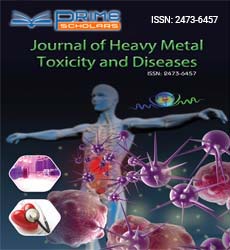Perspective - (2023) Volume 8, Issue 3
Minamata Disease: Causes and Treatment
Song Yano*
Department of Occupational Medicine and Clinical Toxicology, Lanzhou University, China
*Correspondence:
Song Yano,
Department of Occupational Medicine and Clinical Toxicology, Lanzhou University,
China,
Email:
Received: 01-May-2023, Manuscript No. ipjhmct-23-17456;
Editor assigned: 03-May-2023, Pre QC No. ipjhmct-23-17456 (PQ);
Reviewed: 17-May-2023, QC No. ipjhmct-23-17456;
Revised: 22-May-2023, Manuscript No. ipjhmct-23-17456 (R);
Published:
29-May-2023, DOI: 10.21767/2473-6457.23.3.27
Introduction
Minamata Disease, a devastating neurological disorder caused
by mercury poisoning, remains a haunting reminder of the consequences
of environmental negligence. Tragically, this resulted
in widespread neurological and physical impairments, affecting
1000s of individuals, including unborn babies. The symptoms of
Minamata Disease can vary in severity but often include sensory
disturbances (such as numbness and tingling), muscle weakness,
vision and hearing impairments, difficulty walking, and cognitive
dysfunction. In severe cases, the disease can lead to paralysis,
coma, and even death.
Description
Minamata Disease is primarily caused by the ingestion of methylmercury,
a highly toxic form of mercury. The main sources of
methylmercury exposure in the context of Minamata Disease are
industrial waste and contaminated seafood. Mercury, a heavy
metal, is released into the environment through industrial processes,
such as chemical production, mining, and waste incineration.
These pollutants find their way into water bodies, where
they are converted by bacteria into methylmercury, a bioavailable
form that can easily accumulate in aquatic organisms. In
the case of Minamata, a local chemical factory released methylmercury-
contaminated wastewater into the Minamata Bay over
several decades. The methylmercury biomagnified in the food
chain, with small fish accumulating the toxin, which was then
consumed by larger fish. This bioaccumulation continued until
the mercury concentration reached dangerous levels, and the
local population, largely dependent on seafood, was exposed to
the toxin. One of the most heart-wrenching aspects of the Minamata
tragedy is the fact that it affected not only those who directly
consumed contaminated seafood but also unborn children
whose mothers were exposed during pregnancy. The disease
caused severe developmental issues, known as congenital Minamata
Disease, leaving affected children with life-long disabilities.
The treatment of Minamata disease focuses on alleviating symptoms
and preventing further exposure to methylmercury. However,
it’s important to note that there is no cure for the disease,
and the damage caused by methylmercury poisoning is often irreversible.
Management of the disease primarily revolves around
supportive care and therapies aimed at improving the quality of
life for affected individuals. Physiotherapy and occupational therapy
can help individuals regain some degree of independence by
addressing motor and sensory impairments. Speech therapy and
counselling are also beneficial for those experiencing communication
difficulties and emotional distress. Medical professionals
closely monitor patients to address complications and ensure
their overall well-being. On a broader scale, preventing Minamata
Disease involves stringent regulations on industrial waste
disposal and pollution control. Governments and industries must
collaborate to implement effective waste management practices,
reducing the release of mercury and other toxic substances
into the environment. Additionally, regular monitoring of water
bodies and aquatic life is essential to identify potential sources of
contamination and mitigate their effects.
Conclusion
Minamata Disease stands as a stark example of the far-reaching
impacts of industrial pollution on human health and the environment.
The disease’s origins in environmental negligence and its
devastating effects on communities emphasize the need for responsible
waste management and sustainable industrial practices.
As we learn from the tragic lessons of Minamata, it is crucial
that governments, industries, and individuals work together to
ensure that history does not repeat itself, and that our actions
prioritize the health and well-being of both current and future
generations.
Citation: Yano S (2023) Minamata Disease: Causes and Treatment. J Heavy Met Toxicity Dis. 08:27.
Copyright: © 2023 Yano S. This is an open-access article distributed under the terms of the Creative Commons Attribution License,
which permits unrestricted use, distribution, and reproduction in any medium, provided the original author and source
are credited.

